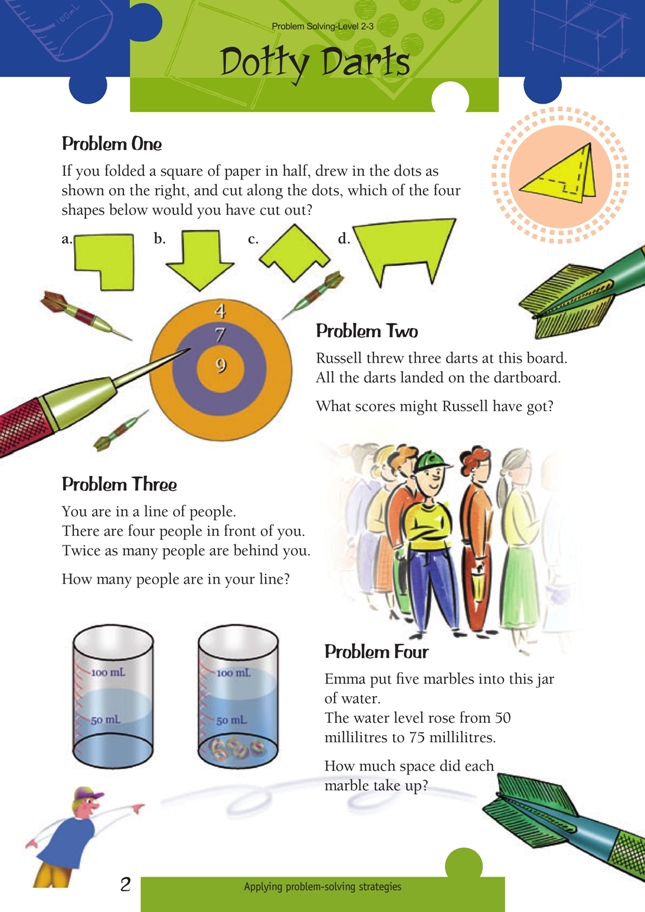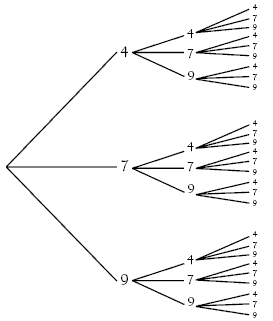These are level 2 number and geometry problems from the Figure It Out series.
A PDF of the student activity is included.
Click on the image to enlarge it. Click again to close. Download PDF (249 KB)
predict result of paper folding (Problem 1)
solve problems using additive strategies (Problems 2, 3, 4)
Problem One
Encourage the students to try visualising the problem first. This is very difficult, so ultimately they ill need to confirm their solution by folding and cutting a piece of paper. Focus the discussion on ow the fold line becomes a line of mirror (reflective) symmetry for the cut-out shape. You may need mirror to show this:
Ask students to fold other pieces of paper in half, draw in cutting lines, and predict the finished shape efore cutting it out.
Problem Two
Many students will approach the problem in a random way and produce a few solutions.
A tree diagram is a good way to find the possible outcomes:
Some combinations result in the same score. For example, 4, 7, 4 has the same score as 7, 4, 4 and 4, 4, 7. One approach is to work through the tree diagram to eliminate these duplications.
Another is to write an organised list:
4 + 4 + 4 = 12, 4 + 4 + 7 = 15, 4 + 4 + 9 = 17, 4 + 7 + 7 = 18, 4 + 7 + 9 = 20, 4 + 9 + 9 = 22
(This eliminates any score where a dart lands on a 4.)
7 + 7 + 7 = 21, 7 + 7 + 9 = 23, 7 + 9 + 9 = 25 (This eliminates any further scores where a dart lands on a 7.)
9 + 9 + 9 = 27 is the only remaining score.
If students find this problem too difficult to start with, simplify it by saying that Russell threw two darts and build up possible strategies before proceeding to the three-dart problem.
Problem Three
A physical model of the problem is useful. Counters can be used, or students may act it out. Encourage a systematic approach supported by reasoning.
“I knew there were thirteen people in the line because there were four in front of me, twice that number, eight, behind me, and four plus eight plus one is 13.”
The problem can be made more complex by changing the conditions, for example:
“Twelve people are in front of you, and half as many people are behind you.”
“You are in a dance formation. Four people are in front of you, and four are behind you. Twice as many people are to your right, and three times as many are to your left. How many people are in the formation?”
Problem Four
Students will need to look carefully to determine that the water level rose by 25 millilitres. This means that each marble displaced 25 ÷ 5 = 5 millilitres and has a volume of 5 cubic centimetres (cm3 or cc).
Note: 1 mL = 1 cc. Students may not know this.
Ask students how many marbles would be needed to get the water level to rise up to
100 millilitres. At that point, half the volume will be marbles and the other half water. Tell them to draw another jar where the volume is half marbles and half water.
“What about three-quarters marbles and one-quarter water?” (For this question, students will need to think about the size of the jar and the volume of water in the jar.)
Answers to Problems
1. c
2. The possible combinations need to include darts landing in the same ring:
4 + 4 + 4 = 12
4 + 4 + 7 = 15
4 + 4 + 9 = 17
4 + 7 + 7 = 18
4 + 7 + 9 = 20
4 + 9 + 9 = 22
7 + 7 + 7 = 21
7 + 7 + 9 = 23
7 + 9 + 9 = 25
9 + 9 + 9 = 27
3. 13
4. 5 cc



